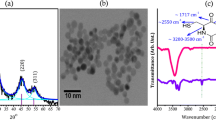Abstract
A surface modification approach adopting polymer encapsulation was developed to prepare zwitterion-like quantum dots (ZWL-QDs). The fundamental physical, chemical, and biological properties of the ZWL-QDs were characterized. It is found that the ZWL-QDs almost preserve the quantum yield (QY) of native hydrophobic QDs in organic solvents, and also are compact in size (7 ~ 10 nm hydrodynamic diameter) and stable over wide pHs or in high salinity solutions. Further cellular study shows that the ZWL-QDs with a concentration less than 100 nM have a minimal cytotoxicity and thus are biocompatible. Characterizing and understanding these essential properties of the ZWL-QDs are an important step before employing them for various applications.







Similar content being viewed by others
References
Al-Jamal WT, Kostarelos K (2011) Liposomes: from a clinically established drug delivery system to a nanoparticle platform for theranostic nanomedicine. Acc Chem Res 44:1094–1104
Bagalkot V, Gao X (2011) siRNA-aptamer chimeras on nanoparticles: preserving targeting functionality for effective gene silencing. ASC Nano 5:8131–8139
Booth M, Peel R, Partanen R, Hondow N, Vasilca V, Jeukenb LJC, Critchley K (2013) Amphipol-encapsulated CuInS2/ZnS quantum dots with excellent colloidal stability. RSC Adv 3:20559–20566
Breus VV, Heyes CD, Tron K, Nienhaus GU (2009) Zwitterionic biocompatible quantum dots for wide pH stability and weak non-specific binding to cells. ACS Nano 3:2573–2580
Bruchez M Jr, Moronne M, Gin P, Weiss S, Alivisatos AP (1998) Semiconductor nanocrystals as fluorescent biological labels. Science 281:2013–2016
Delehanty J, Blanco-Canosa J, Bradburne C, Susumu K, Stewart M, Prasuhn D, Dawson P, Medintz I (2013) Site-specific cellular delivery of quantum dots with chemoselectively-assembled modular peptides. Chem Commun 49:7878–7880
Giljohann DA, Seferos DS, Prigodich AE, Patel PC, Mirkin CA (2009) Gene regulation with polyvalent siRNA-nanoparticle conjugates. J Am Chem Soc 131:2072–2073
Huang L, Zhu X, Publicover NG, Hunter KW, Ahmadiantehrani M, de Bettencourt-Dias A, Bell TW (2013) Cadmium and zinc alloyed Cu-In-S nanocrystals and their optical properties. J Nanopart Res., 15, doi:10.1007/s11051-013-2056-9.
Kievit FM, Veiseh O, Bhattarai N, Fang C, Gunn JW, Lee D, Ellenbogen RG, Olson JM, Zhang M (2009) PEI-PEG-Chitosan copolymer coated iron oxide nanoparticles for safe gene delivery: synthesis, complexation, and transfection. Adv Funct Mater 19:2244–2251
Lee H, Kim IK, Park TG (2010) Intracellular trafficking and unpacking of siRNA/quantum dot-PEI complexes modified with and without cell penetrating peptide: confocal and flow cytometric FRET analysis. Bioconjugate Chem 21:289–295
Lees E, Nguyen T, Clayton A, Mulvaney P (2009) The preparation of colloidally stable, water-soluble, biocompatible, semiconductor nanocrystals with a small hydrodynamic diameter. ACS Nano 3(5):1121–1128
Liu X, Huang H, Liu G, Zhou W, Chen Y, Jin Q, Ji J (2013) Multidentate zwitterionic chitosan oligosaccharide modified gold nanoparticles: stability, biocompatibility and cell interactions. Nanoscale 5:3982–3991
Mei B, Susumu K, Medintz I, Delehanty J, Mountziaris T, Mattoussi H (2008) Modular poly (ethylene glycol) ligands for biocompatible semiconductor and gold nanocrystals with extended pH and ionic stability. J Mater Chem 18:4949–4958
Muro E, Pons T, Lequeux N, Fragola A, Sanson N, Lenkei Z, Dubertret B (2010) Small and stable sulfobetaine zwitterionic quantum dots for functional live-cell imaging. J Am Chem Soc 132:4556–4557
Muro E, Fragola A, Pons T, Lequeux N, Ioannou A, Skourides P, Dubertret B (2012) Comparing intracellular stability and targeting of sulfobetaine quantum dots with other surface chemistries in live cells. Small 8:1029–1037
Resch-Genger U, Grabolle M, Cavaliere-Jaricot S, Nitschke R, Nann T (2008) Quantum dots versus organic dyes as fluorescent labels. Nat Methods 5:763–775
Sperling RA, Parak WJ (2010) Surface modification, functionalization and bioconjugation of colloidal inorganic nanoparticles. Phil Trans R Soc A 368:1333–1383
Susumu K, Uyed H, Medintz I, Pons T, Delehanty J, Mattoussi H (2007) Enhancing the stability and biological functionalities of quantum dots via compact multifunctional ligands. J Am Chem Soc 129:13987–13996
Uyeda H, Medintz I, Jaiswal J, Simon S, Mattoussi H (2005) Synthesis of compact multidentate ligands to prepare stable hydrophilic quantum dot fluorophores. J Am Chem Soc 127:3870–3878
Veiseh O, Kievit FM, Fang C, Mu N, Jana S, Leung MC, Mok H, Ellenbogen RG, Park JO, Zhang M (2010) Chlorotoxin bound magnetic nanovector tailored for cancer cell targeting, imaging, and siRNA delivery. Biomaterials 31:8032–8042
Yezhelyev MV, Qi L, O’Regan RM, Nie S, Gao X (2008) Proton-sponge coated quantum dots for siRNA delivery and intracellular imaging. J Am Chem Soc 130:9006–9012
Yu W, Chang E, Falkner J, Zhang J, Al-Somali A, Sayes C, Johns J, Drezek R, Colvin V (2007) Forming biocompatible and nonaggregated nanocrystals in water using amphiphilic polymers. J Am Chem Soc 129:2871–2879
Zhou J, Wang Q, Zhang C (2013) Liposome–quantum dot complexes enable multiplexed detection of attomolar DNAs without target amplification. J Am Chem Soc 135:2056–2059
Zimmer J, Kim S, Ohnishi S, Tanaka E, Frangioni J, Bawendi M (2006) Size series of small indium arsenide-zinc selenide core-shell nanocrystals and their application to in vivo imaging. J Am Chem Soc 128:2526–2527
Acknowledgments
This research was supported by the National Institute of Health through the grant #1P20GM103650-01.
Author information
Authors and Affiliations
Corresponding authors
Rights and permissions
About this article
Cite this article
Huang, L., Liao, M., Chen, S. et al. A polymer encapsulation approach to prepare zwitterion-like, biocompatible quantum dots with wide pH and ionic stability. J Nanopart Res 16, 2555 (2014). https://doi.org/10.1007/s11051-014-2555-3
Received:
Accepted:
Published:
DOI: https://doi.org/10.1007/s11051-014-2555-3




